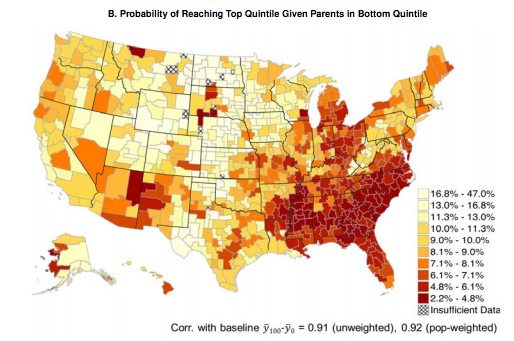This image was going around a few weeks ago showing upward mobility by region. Notice how Yuppiehood is greatly diminished in conservative regions. Again, I’m not that partisan, it’s just that current GOP policies do not work:
The Atlantic — But it’s a little deceiving to talk about “our” mobility rate. There isn’t one or two or even three Americas. There are hundreds. The research team of Raj Chetty, Nathaniel Herndon, Patrick Kline, and Emmanuel Saez looked at each “commuting zone” (CZ) within the U.S., and found that the American Dream is still alive in some parts of the country. Kids born into the bottom 20 percent of households, for example, have a 12.9 percent chance of reaching the top 20 percent if they live in San Jose. That’s about as high as it is in the highest mobility countries. But kids born in Charlotte only have a 4.4 percent chance of moving from the bottom to the top 20 percent. That’s worse than any developed country we have numbers for.


Looking at the map, it is hard not note that east from the Mississippi the areas with lowest social mobility constitute the heart of the old Confederacy. Certainly a large element is racial. There is an interesting cluster in western South Dakota that almost certainly represents the presence of native american reservations. Racism is the root cause of much American social disfunction.
Wait a sec .. how do you define an America here?
Are we talking landmass or culture or what? (Yeah, probably too nitpicky ,literal and pedantic but still really how do you define an America? What is meant by that?)
PS. Far as I know the convention is that there are two America’s – one North and one South each a continent and together making up the new World. I suppose you can add a third in the peninsula joining them known as ether / both Central or / and Latin America.
I guess the United States of America is another distinct subset implying no doubt (often?) wrongly that the provinces comprising Canada and Mexico and the various nations of South and Central America are disunited! Then we start getting into the metaphorically murky realm of metaphors don’t we where “America” becomes ever finer slices of economic and social and experienced or imagined division maybe? Is that it?
Let us all thank 30+ years of Reaganomics and wrose pushed by the Republican party for making the American Dream less of a reality and more of a dream than ever.
Potentially even worse is that reaching the top 20% doesn’t mean what it used to anymore in the US (I’m not sure if reaching the top 20% is more meaningful in other 1st world countries or not). $100k / year will put you in the upper 20% (per WSJ’s calculator), but $100k / year is not particularly great if you live somewhere like New York (which you probably are if you are making $100k). This isn’t to say that $100k is bad, but I would imagine most people are thinking more along the lines of $200k or more to be in the upper 20%. In reality, $100k in an expensive area to live in looks a lot more like middle class than upper class…
I’d be interested in seeing graphics for other values as well (e.g. bottom 5% to top 5%, bottom third to top third) and see if the pattern still holds up. Also it be interesting to see those born to the middle (say 40% to 60% band who ends up at the top 10% AND bottom 10% – see how the middle class is faring). The other thing that I’d like to see is the above based on at least 1960, 1980 and 2000 values to see if there is an erosion (or increase) in mobility and how much over time. Finally, it would be useful to see the graphic based on gender and one based on race.
This is a good start, but far from a complete picture.
@Steveo, #2: You sound like my mother, so I’ll point out, as always, that there is only one country in the world with “America” in its name. There is, however, another “United States” right here on the continent, Estados Undios Mexcanos or United States of Mexico.
I notice the lightest area in the country is North Dakota. That’s no doubt a recent, and probably temporary, result of the oil boom going on there.
@johnb
It’s not just west river (western SD) where the reservation counties lag; you can see it ND/Montana and NM and Arizona (a fair number of the insufficient data counties are reservation, and if the data were available, would show up the same color.) Just looking at the map, I can pick out Shannon and Bennett (Pine Ridge Reservation); Todd (Rosebud); Cheyenne River and Standing Rock (which extends into ND) pretty easily; several other counties with large American Indian populations would be more obvious if this county showed census tracts rather than counties. You can find the Ft Peck and Blackfoot Reservations, and the Northern Cheyenne and Crow Reservations in Montana; Turtle Mountain and the Mandan/Arikira/Hdsata in ND and the Navajo and Hopi down in NM/AZ pretty easily too.
The south though – man, what can you say about that
Why does Utah have such upward mobility? Are they going a-viking and looting other states?
Is the poor situation in Maine correlated to the Indian reservations?
Is the big island in Hawaii dominated by polynesians?
West Virginia seems to be doing fine, an island in an ocean of misery.
As for the folks further south, if they hope to get social mobility in their lifetimes I would recommend they migrate to some Scandinavian country…(no gerrymandered districts, a proportional voting system favoring a multi-party system and decent education)